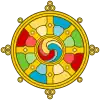| Part of a series on |
| Tibetan Buddhism |
|---|
 |
The term nyönpa (Wylie: smyon pa "mad one(s)"; Sanskrit avadhūta) may refer to a group of Tibetan Buddhist yogis or a single individual belonging to this group. They are mainly known for their unorthodox approach and philosophical foundation known as "tulshuk chöpa." Nyönpas are a group of yogis who break away from traditional norms, emphasizing spontaneity and intuition over rigid rules.
Their nomadic lifestyle, devoid of settled abodes, reflects their rejection of societal conventions, while their unique attire further sets them apart as unconventional practitioners. The consumption of substances considered impure and engagement in behaviors like singing, dancing, and even sexual relations challenge conventional notions of spiritual practice, underlining their commitment to enlightenment beyond established boundaries. Noteworthy historical figures, including Drukpa Kunley and Sönam Peldren, showcase the nyönpa tradition's enduring influence and its ability to reshape spiritual narratives.
The nyönpa tradition's legacy stands as a testament to the dynamic nature of Tibetan Buddhism. By embracing the philosophy of "tulshuk chöpa," nyönpas demonstrate that the path to enlightenment can be as diverse and individualistic as the practitioners themselves. Through their rejection of normative behaviors and their fearless embrace of unconventional practices, the nyönpas inspire understanding of spiritual growth towards greater self-awareness and enlightenment.
Spiritual practices
Recent scholarship has helped to illuminate many distinguishing features of the religious practices the nyönpa; these practices are sometimes referred to in the literature as The Practice of Observance.[1] The Practice of Observance takes as its foundation the philosophy of tulshuk or chöpa or even tulshuk chöpa.[1] This religious philosophy is the common thread in the following spiritual practices of the nyönpa:[1]
The nyönpa is essentially a free spirit who follows the rule of spontaneity and intuition, not subject to any external book of rules....he is one dedicated to renunciation and the path of enlightenment who does not fit within the disciplines and practises of the formal orders.
- wandering homeless and taking on a new style of dress and a new mental attitude towards the world;
- consuming substances considered impure;
- drinking alcohol and eating meat;
- singing and dancing;
- behaving fearlessly;
- engaging in sexual relations.
None of the practises listed above should be taken as mandatory.
Practices that a nyönpa may avoid include:
- reading spiritual texts;
- reciting prayers in the usual ways.
Some nyönpa were also famous for the practice of chöd.
Notable examples
There are some recorded historical descriptions of those exhibiting the behavior and spiritual practice of the nyönpa in both Tibet and India including:
- Drukpa Kunley
- Gendün Gyatso, the Second Dalai Lama
- Kalapa, the "Handsome Madman", one of the 84 Mahasiddas
- Mekhala and Kankhala, often called the "Two Headless Sisters", also part of the group of the 84 Mahasiddas
- Thang Tong Gyalpo
- Tsangnyön Heruka[2]
- Ü Nyön Kunga Zangpo[3][4]
- Milarepa[3]
Women and the path
There is evidence that women also took inspiration from the spiritual practices and ways of conduct of the nyönpa.
The most famous Tibetan woman exhibiting signs of the path of the nyönpa would be the Tibetan female saint Sönam Peldren who probably lived in the 14th century.[5] Sönam Peldren was eventually understood as an emanation of Vajravārāhī in the female tulku incarnation lineage of the Samding Dorje Phagmo.[5][6]
Before this, in India, there were three women in the grouping of the 84 Mahasidda whose spiritual behavior would indicate that they practiced according to this spiritual path. They are Lakṣmīṅkarā, the "Crazy Princess", and the "Two Headless Sisters" Mekhala and Kanakhala.
See also
- Divine madness – Behavior linked to spiritual pursuits
References
Citations
Works cited
- Bessenger, Suzanne (2016). Echoes of Enlightenment: The Life and Legacy of the Tibetan Saint Sonam Peldren. Oxford University Press.
- Diemberger, Hildegard (2007). When a Woman Becomes a Religious Dynasty: The Samding Dorje Phagmo of Tibet. Columbia University Press. ISBN 978-0-231-14320-2.
- DiValerio, David M. (2015). The Holy Madmen of Tibet. Oxford University Press.
- DiValerio, David M. (2016). The Life of the Madman of Ü. Oxford University Press.
Further reading
- Ardussi, J.; Epstein, L (1978). "The Saintly Madman in Tibet". In Fisher, James F. (ed.). Himalayan Anthropology: The Indo-Tibetan Interface. Paris. pp. 327–38.
{{cite book}}: CS1 maint: location missing publisher (link) - Larsson, Stefan (2007). "Crazy Yogins During the Early Renaissance Period". collab.itc.virginia.edu. Retrieved 2022-10-04.
- Larsson, Stefan (2012). Crazy for Wisdom: The Making of a Mad Yogin in Fifteenth-century Tibet. Leiden: Brill.